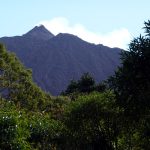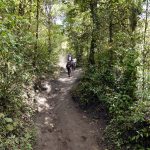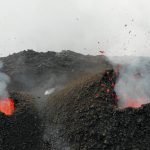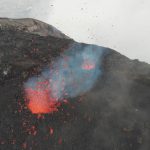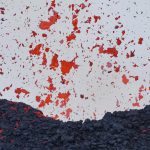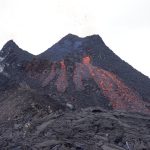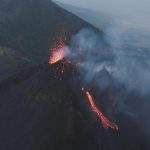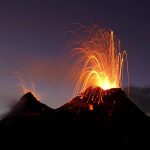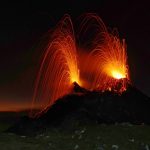In January 2020 I spent 3 days at the volcano Pacaya in Guatemala. Since months the fire mountain was strombolian active and produced lava flows from time to time. So the volcano attracted me for the 2nd time within 2 years. Compared to March 2018 the hornito was much larger and now had 2 distinct chimneys, both of which were active.
Jaime, the host of Salamandras House picked me up Friday evening with his pickup truck from the airport in Guatemala City. The man from El Salvador greeted me warmly and took me to the supermarket on the way to Pacaya. There is no serious shopping possibility directly at the volcano. Only a small kiosk offers sweets and beer, which is the most important thing to get along at the volcano for a while. Arriving at the inn I thought about climbing up directly in the first night, but somehow the tiredness won. Strong wind and clouds didn’t motivate me very much and so I climbed the Pacaya only the next morning.
The first part of the ascent did not pose any particular hurdles, except for the fact that the first hundred meters of altitude difference are quite steep. As the park entrance (yes, the Pacaya is protected in a national park and one has to pay 50 Quetzales entrance fee) is located at a height of barely 1700 m, I immediately started to breathe and sweat. But with increasing height at least the sweating stopped. At the end of the vegetation zone, all those volcano hikers who had joined a guided group gathered and looked longingly to the summit. The last 300 meters of altitude difference can still be climbed – contrary to the rules – but one must not be deterred or stopped by the prohibition signs and the rather steep path through loose lapilli. So I stomped on determinedly and stood at the edge of the My Kenney crater at noon and looked at the two hissing chimneys of the hornito.
At first, only a few isolated lava lumps were ejected from the mouths of the chimneys, but pretty soon the activity increased to continuous lava spattering. Isolated lava bombs reached respectable heights of about 50 meters. Also the size of the cinders was impressive.
In the late afternoon a new vent opened on the flank of the hornito. Lava flows out of it, which poured over the flank in a multi-armed stream. The spectacle was quite entertaining and ended after 10 minutes.
Within 2 hours I flew the 3 batteries of my drone empty and let it float dangerously low over the vents. I was quite surprised that at the end of the battery capacity it had actually not yet been shot down, with the lava bombs taking on the role of missiles: more than once they came dangerously close to the unmanned aircraft.
In the evening it became quite windy again at the crater rim, but I persevered and waited for the moonrise. Around 21.30 o’clock our Trabant then pushed itself slowly over the horizon and showed again the contours of the hornito. A little later I started the descent. Arrived down in the forest I paused for a while and let the various voices of the night take effect on me.
2 days later I set off for the Fuego, which my drone should not survive, but more of that elsewhere.

